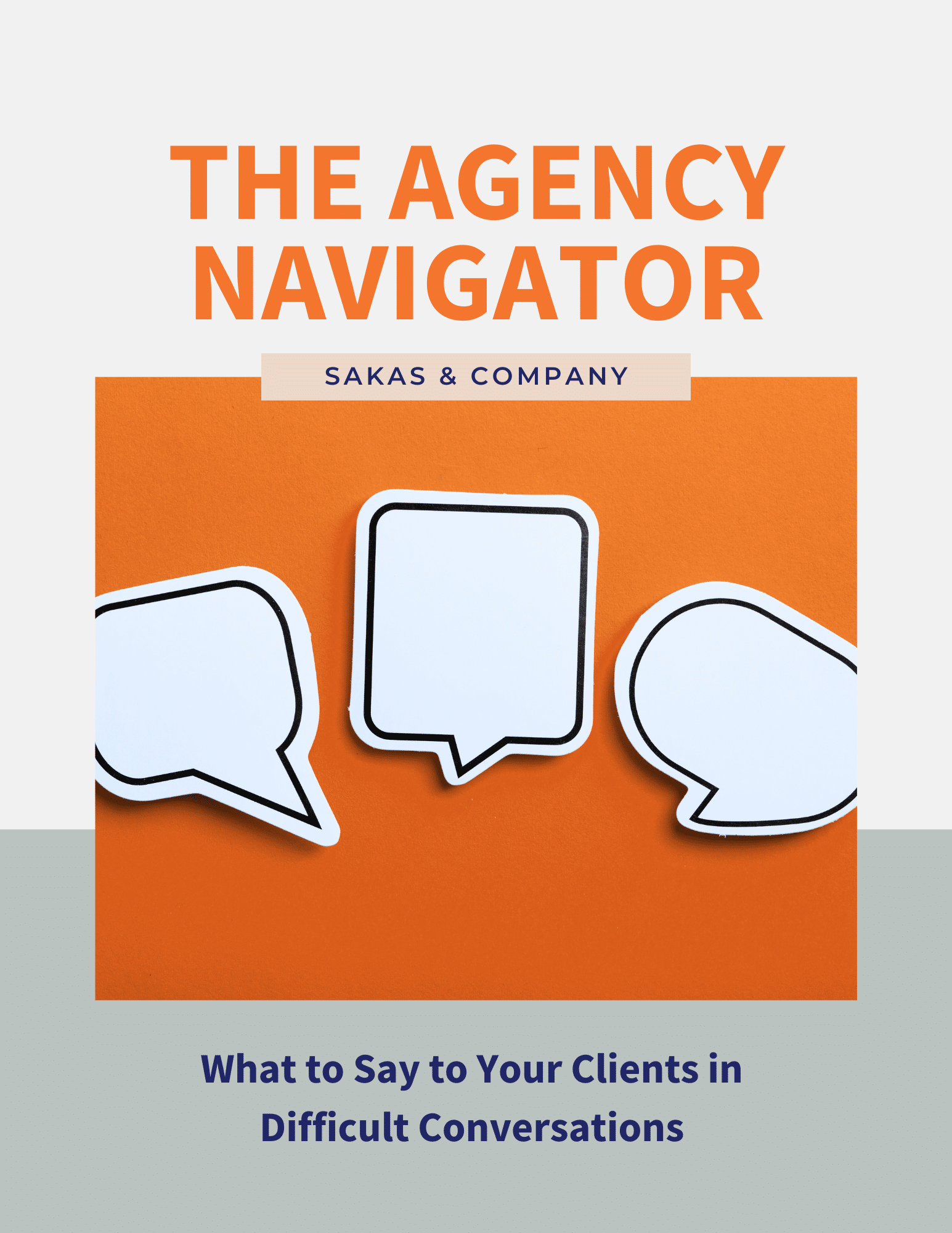Are you tired of dealing with constant client emergencies at your agency? After my latest INBOUND talk—on handling difficult clients—an agency leader asked me for advice:
“We have a disorganized client that keeps changing the priority of work they want done. We have to put current projects on hold—including nearly-complete projects—to handle their latest emergency. The constant emergencies make it difficult to complete the promised scope of work. And it’s driving me and my team crazy. What should we do?”
Frustrating, right? Fortunately, there are ways to solve this—or to conclude you need to part ways with the client. If you decide you can’t handle client emergencies—or you don’t want to handle a specific client’s emergencies—you’ll need to create alternatives.
To help you decide what to do, let’s look at 10 questions to ask about client emergencies at your agency—and then four ways to create a profitable new revenue stream around handling client emergencies.
10 questions to ask about client emergencies
Answer these 10 questions to troubleshoot your agency’s unique “client emergencies” problem. If you don’t know the answer, ask the team member who “owns” each client relationship. Many of these are questions to ask about each individual client, but you’ll want to look for patterns across your entire client base and your entire team.
1. Do you want to handle client emergencies at your agency?
Some agencies thrive on handling emergencies. (At the end of the article, I share four ways to make this profitable.) But if you prefer a more 9-5 schedule, you probably should avoid offering emergency services.
If you don’t want to handle client emergencies, consider how to give clients alternatives. This might mean referring clients to a trusted partner agency for maintenance and support, or creating a special escalation process that points people to the right helper (like how medical practices will have an after-hours answering service).
2. Are the emergencies truly emergencies from the agency’s perspective?
I realize these are emergencies from the client’s perspective—but are they emergencies from the agency’s perspective? In some cases, you may need to re-educate your clients about what’s truly an emergency versus what can wait ’til the next business day. Charging an emergency surcharge or other rush rate can “help” them decide.
3. Are the emergencies preventable if the client planned ahead?
As Director of Client Services at an agency, I had a problematic legacy client. His email promos were so effective, they’d take down his website due to the flood of incoming traffic. Unfortunately, this also took down the other sites on the shared server… including the agency’s custom PM system.
We offered several solutions, but he refused to upgrade to dedicated hosting. We ultimately parted ways because he wasn’t willing to change his behavior. (This is part of why most agencies shouldn’t offer web hosting services.)
4. Is the client typically reactive in all of their activities?
Take a look at other aspects of the client’s business. Are they reactive about everything, or just this? In many cases, this is just how the client chooses to operate, and you’re unlikely to be the one to change their behavior. You can try… but think twice before tilting at windmills.
5. Is your team willing to work on emergency requests?
Can your agency even handle client emergencies? Not everyone has the bandwidth, or a team willing to make it happen. Client emergencies make life harder for you and your team.
Some of this varies by agency and by role. If your agency specializes in crisis communications or emergency web development support, most employees should know what to expect. But if your regular work is Monday-through-Friday, having someone on-call every weekend may not go smoothly.
6. Can you staff things so that different people handle ongoing vs. emergency work?
Can you separate emergency requests from “regular” requests? You ideally don’t want to pull people off ongoing work to handle emergencies—but that’s not always an option.
I see this in agencies that do software and web development—they’ll often assign maintenance requests to a specific person, while other developers continue working on existing sprints or milestones. This only works if you receive enough one-off requests to keep someone busy, or it’s a match for your stable of freelancers.
7. Does the client have any reason to care that other work is delayed?
That is, does the client feel any “pain” from the delay they’ve created while you handle the new emergency? Are you charging a rush rate for emergency fixes, or charging a project delay fee?
The penalty doesn’t have to be purely financial, too. You can use Reason-Options-Choose to help them understand non-financial tradeoffs. For example:
- “If we handle this now, it’ll delay the XYZ project by at least a week. Are you OK with that?”
- “We can shift budget to handling this, but it means we’d need to drop the ABC feature. Should we proceed?”
- “If we prioritize this, it would consume your retainer for the rest of the month, and we’d pause further work ’til the 1st. Should we plan on that, or would you prefer to add extra budget?”
Most clients understand the need to make tradeoffs, unless they’re entitled. Speaking of that…
8. Is the client appreciative… or entitled?
This is the most subjective question, but you likely know the answer immediately—especially if they’re super-appreciative or super-entitled.
Does the client acknowledge their request is an emergency, or do they act like it’s business as usual? Do they acknowledge the impact on you and your team? Do they say “thank you”? Do they offer to pre-approve budget to handle things?
You may not see or hear the appreciation in the moment—especially if the client is panicking about something that’s hurting their business. After the initial emergency, pay attention to whether they’re appreciative… and how fast they pay for the extra services.
9. Would you be less frustrated if this were in the budget and the schedule?
Knowing how the client operates, would you be less frustrated if you priced this into the budget and built it into the timeline? That is, the client would be paying “nuisance pricing” when you quote future work (and you’d assume certain “timing TBD, but existence guaranteed” delays in the timeline).
For many agencies, the answer is “yes,” since you’re not surprised—and you’re less likely to resent doing extra, high-pressure work when you get paid extra to handle it.
Be sure to build this into price increases for existing clients. It’s harder with new clients—since you don’t entirely know what to expect—but sales pre-qualification questionnaires and pre-kickoff surveys will help you understand how the client organization operates.
10. If you had revenue tomorrow to replace them, would you “fire” them as a client?
If they’re near the top of your “worst client” list, this relationship likely isn’t a good long-term match. Strengthen your sales pipeline, so you can be more selective about which clients you serve… and apply “strategic churn” to clients who are no longer a match.
Are they a toxic client? You’re hurting team morale and creating an employee retention problem; consider how to fire the client ASAP, even if the revenue will hurt. (And all the more reason to be careful about Client Concentration.)
If you want to handle client emergencies at your agency—and they aren’t a “structural” problem based on the answers above—read on for ways to make this profitable!
Revenue streams: 4 ways to make client emergencies profitable
Some agencies make client emergencies a profitable part of their revenue model. For example, this includes offering emergency-oriented services like:
- Crisis communications, reputation management, and other urgent PR
- eCommerce web development, including emergency support to minimize client downtime
- Troubleshooting and fixing problems created by other agencies
How do you ensure emergency support goes smoothly and profitably, whether a current service or a new revenue stream? Consider the following 4 points.
1. Be sure your team’s on board with handling client emergencies.
Be sure your employees buy-into delivering emergency support. This includes disclosing on-call requirements during the interview process, rotating on-call time in a way that’s fair (and that’s seen as fair), offering incentives for extra work, and acting on employee feedback about how it’s all going.
Delegation is important, but consider occasionally taking some of the on-call rotations yourself (if you’re qualified). You want to lead by example, instead of giving everyone else the dirty work. Agency growth can’t come at the cost of excessive employee turnover, especially your New Rope team members.
2. Charge premium prices for emergency support.
The key is that emergency management is priced-into the agencies’ services. This might be a higher monthly retainer, a mandatory minimum price for emergency “incidents,” or other form of priority rush-rate fees.
For instance, my Executive Coaching clients receive emergency support at no additional charge—where I drop everything and call them back ASAP, even if it’s after-hours. This has included calls while traveling, an emergency call at 11pm, and an emergency call at 7pm on a Friday night. But it’s worth it to me—because I want to be there for my private clients, I charge premium rates, and I assume 1-3 emergencies a year per client (versus, say, weekly).
3. Build a system to manage emergency support requests.
You need a solution for clients to submit emergency requests, to route requests to the appropriate team member at your agency, to gather additional information, and to ensure you get paid for handling the client emergency.
See my article on creating a “rush” workflow, and consider how you might use off-the-shelf customer support software to implement things. You might need a custom solution—but don’t “reinvent the wheel” unless absolutely necessary.
4. Create and follow a service level agreement (SLA) for emergency support.
When it comes to offering emergency support services, agencies should create and follow a service level agreement (SLA). The SLA lays-out what’s included, what’s extra, how fast the agency will respond, and how the client should “trigger” an emergency request.
This helps ensure your agency handles emergencies promptly, and that you get paid appropriately; everyone’s happy.
Question: How do you handle client emergencies at your agency?


